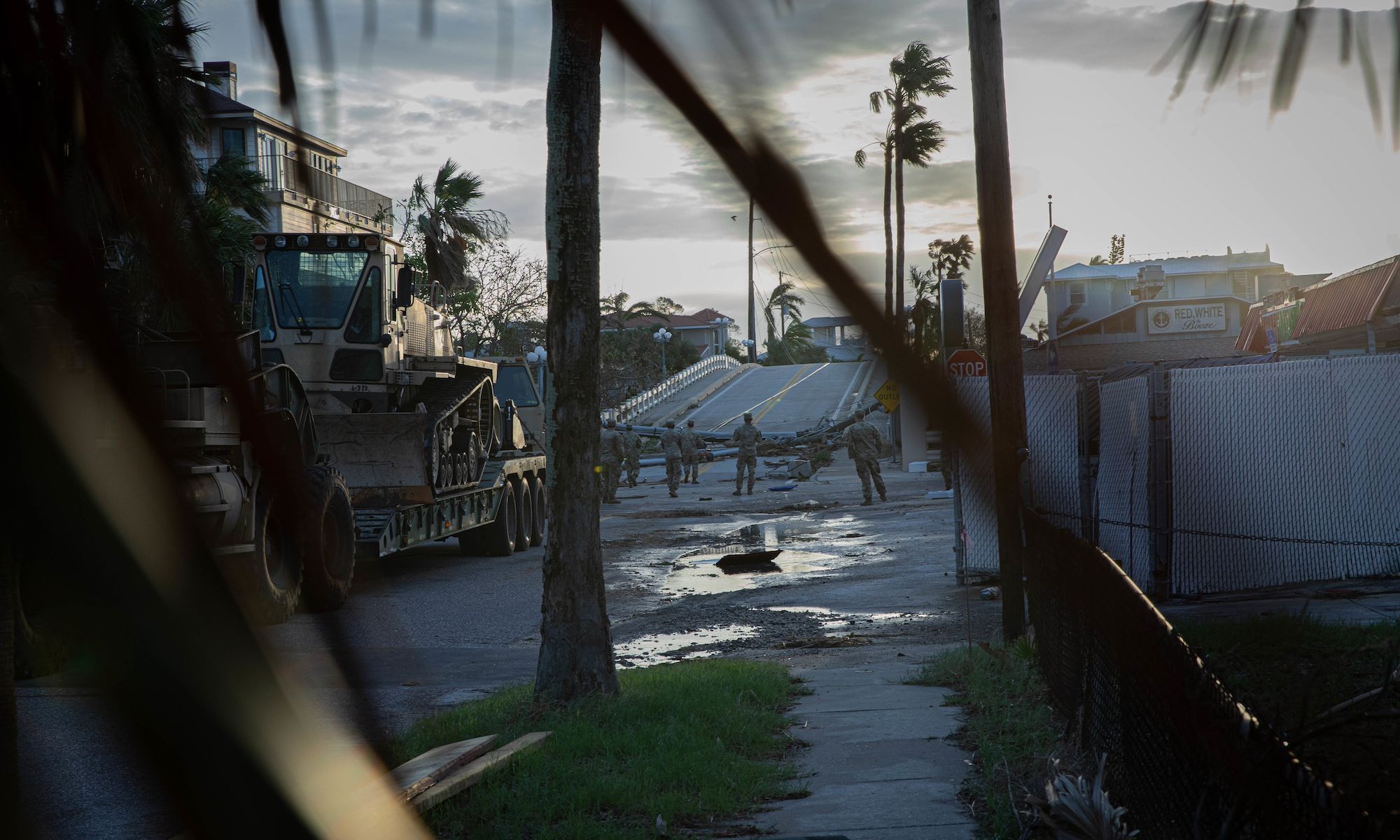Members of the Florida Army National Guard help with Hurricane Milton recovery in Pass-a-Grille, Florida, on 10 October US Army Photo by Sgt Maddie Fortune, via Flickr
In the wake of Hurricane Milton making landfall last week near Sarasota on Florida’s Gulf Coast, millions across the state—including many who had just started picking up the pieces after Hurricane Helene’s devastating impact less than two weeks prior—have begun the long recovery process. Many art organisations in and near Sarasota, Tampa Bay and St Petersburg especially experienced Hurricane Milton’s destructive force firsthand.
According to a statement released by the Ringling in Sarasota—whose campus includes an art museum, circus museum, historic home and more—its historical and opulent home, Ca’ d’Zan, sustained limited damage. There was no damage to its glass façade, which faces directly onto Sarasota Bay. The Ringing’s Circus Museum did experience roof damage and there is a larger repair underway. The institution estimates that the Circus Museum will be closed for the next two weeks. The Museum of Art and the Tibbals Learning Center wing of the Circus Museum emerged relatively unscathed.
As with Hurricane Ian two years ago, Hurricane Milton’s biggest impact on the Ringling’s campus was to its grounds, where several trees had to be taken down and there was “a lot of damage to our banyans”, according to a spokesperson’s statement.
"Sarasota is lucky to have a robust arts community who work very well together,” Steven High, the Ringling’s executive director, tells The Art Newspaper. “Because of that, we feel certain that recovery from this storm will be swift and uniting.”
The Tampa Museum of Art made it through Hurricane Milton relatively unharmed after Tampa Bay was spared a direct hit by the storm. The museum reopened to the public on 12 October. In a message released on social media, the museum stated: “In light of the ongoing recovery efforts and challenges many face, we invite those experiencing hardships such as power outages or displacement, to find a moment of tranquillity in our galleries or to use our free wifi and recharge your devices and find a moment of peace.”
The Sarasota Art Museum experienced some damage to its grounds and outdoor features. There was wind damage to its exterior signage and fencing, and some plants and trees were shredded or uprooted. One tree fell onto Complexus (2007), a large outdoor sculpture by John Henry that is installed on the museum's grounds.
During Hurricane Milton, a tree fell on John Henry's Complexus (2007), a sculpture on loan to Sarasota Art Museum from the City of Sarasota's public art programme Courtesy of Sarasota Art Museum
A spokesperson for the Sarasota Art Museum said the institution lost power at around 6:45pm on 9 October and was without electricity for 17 hours. As a result, their bistro lost a refrigerator full of food, but the museum was able to reopen to the public for free on 15 October.
“Artists are inherently resilient and creative,” Virginia Shearer, the Sarasota Art Museum’s executive director, tells The Art Newspaper. “There have been such incredible stories of artists who are meeting these challenges head on and helping one another out—bringing over chainsaws and helping clear debris. It’s very inspiring and not at all surprising that our artists lead the way in collaborating to rebuild and model how to be resilient in the face of disaster.”
The Robert Rauschenberg Foundation, which operates an artist-in-residence programme at Robert Rauschenberg’s former property on the island of Captiva, is still assessing the damage from Hurricane Milton. The foundation’s staff evacuated ahead of the storm and are safe.
“We are also mindful of the recent devastation across the southeast caused by Hurricane Helene that has impacted so many artists and cultural workers,” Courtney J. Martin, the Rauschenberg Foundation’s executive director, wrote to The Art Newspaper over email. “While the full effects of the recent storm are not yet clear, we remain committed to supporting our community in the days ahead and will provide updates as more information becomes available.”
Another art residency along the Gulf Coast, the Hermitage Artist Retreat in Englewood, was left with upwards of $1m in damage from Hurricane Milton, according to Artnews.
As of this writing more than 400,000 people in Florida are without power, gas stations are still dealing with fuel shortages and there is still widespread flooding in many areas. Recent satellite photography also revealed that Milton actually reshaped parts of Florida's coastline.
Even before hurricanes Helene and Milton hit the state, arts organisations in Florida were reeling from Governor Ron DeSantis's funding cuts. His last-minute veto of the full $32m in state arts funding for fiscal year 2025 left many organisations scrambling to find alternative funding sources and facing difficult decisions about how to maintain their programming.
Many arts organisations throughout the southeastern United States—especially in western North Carolina—are still reeling from the cataclysmic impacts of Hurricane Helene. In Asheville, North Carolina, the executive director of the non-profit organisation ArtsAVL, Katie Cornell, has estimated that around 80% of the city’s River Arts District was destroyed by Hurricane Helene.
“For perspective, the River Arts District was home to 26 warehouses and 300 artists,” Cornell told WTVD. “The loss is devastating.”

